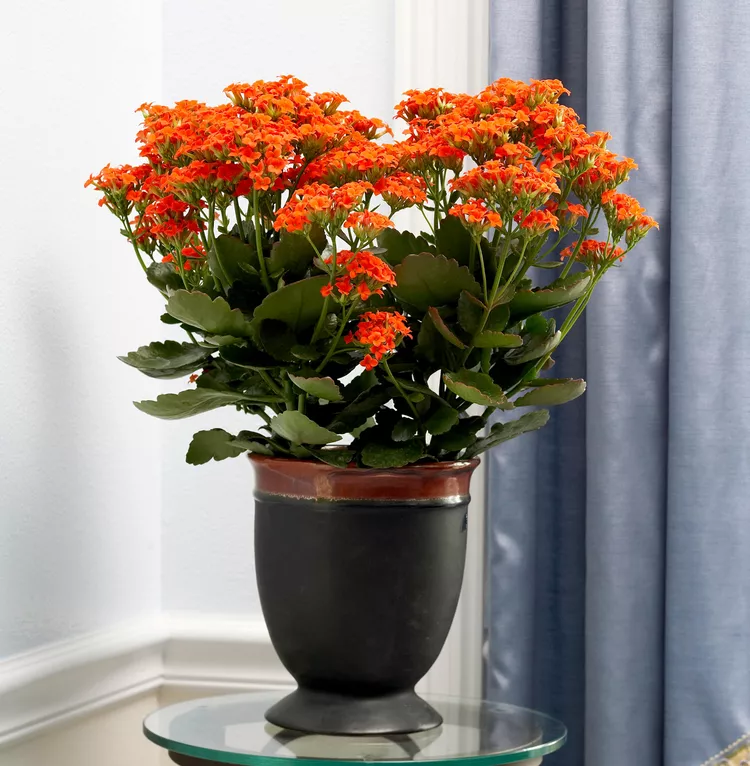How to Plant and Grow Kalanchoe

In tropical environments, kalanchoe thrives in outdoor garden beds. But gardeners in less temperate zones appreciate it as a low-maintenance houseplant that grows to about 6 to 12 inches tall with fleshy, succulent leaves. Flowers blanket some varieties; others sport fuzzy leaves in various shapes and sizes.
Kalanchoe bursts into bloom during the gray winter and early spring months. Its tiny red, white, pink, yellow, or orange flowers cluster into dense groups above a skirt of dark green foliage. Count on the blooms to last for several weeks. It's especially striking in the tropics when grown in pots on a patio or porch.
Kalanchoe Overview
| Genus Name | Kalanchoe |
| Common Name | Kalanchoe |
| Plant Type | Houseplant, Perennial |
| Height | 6 to 12 inches |
| Width | 6 to 36 inches |
| Flower Color | Orange, Pink, Red, White, Yellow |
| Foliage Color | Blue/Green |
| Season Features | Fall Bloom, Reblooming, Spring Bloom, Summer Bloom, Winter Bloom |
| Zones | 10, 11 |
| Propagation | Leaf Cuttings, Stem Cuttings |
| Problem Solvers | Drought Tolerant |
Where to Plant Kalanchoe
Kalanchoe grows best in a bright, sunny window inside a house. Patios or entry gardens with plenty of morning light are great spots for potted kalanchoe plants outdoors.
How and When to Plant Kalanchoe
Kalanchoe is an easy-care container plant, whether indoors or outdoors. Plant in well-draining soil in a clay pot, and keep them where they get lots of indirect light. For six weeks in the winter, make sure your kalanchoe is in complete darkness to allow for spring blooms to develop.
Kalanchoe Care Tips
Kalanchoe thrives in a range of environments, indoors and outdoors. If cared for properly, it can live for decades. Make sure not to overwater kalanchoe, which can cause root rot and prevent leaves from growing and blooms from flowering. You'll know you've given your plant too much water if its leaves start to droop.
Light
Kalanchoe needs bright, indirect sunlight when grown indoors and at least 8 hours of direct sunlight outdoors. For it to bloom, it requires a period of six weeks with 14 hours of darkness. Around four months after this dark period, kalanchoe will bloom with colorful flowers.
Soil and Water
Before watering, check the soil. If it's dry to the touch, water the plant. If the soil is moist, wait a few days and recheck the soil. Generally, kalanchoe will need water about once every other week. When in bloom, kalanchoes require more water. Because kalanchoe is a succulent, it will be fine if you're a few days late watering it. Keep well-drained, sandy soil evenly moist, not soggy. Plant in a clay pot to help remove excess water from the soil.
Temperature and Humidity
Kalanchoe will tolerate most indoor environments (55ºF-80ºF) except freezing temperatures, which will kill them. They are also fine with most humidity levels.
Fertilizer
For kalanchoe planted outdoors, fertilize once in the spring. Indoor plants should be fed once a month with a well-balanced mixture, following the manufacturer's instructions, but only in spring and summer. Don't fertilize in winter. Use a high-phosphorous fertilizer if blooms are sparse.
Pruning
Pinch back kalanchoe stems for better blooms and to keep its shape. Groom in spring, when the plant is in growth mode. Don't prune during winter, when it's dormant.
How to Pot and Repot Kalanchoe
Repot kalanchoe with fresh potting mix in a larger container each autumn after blooming to encourage further growth. Deadhead flowers to keep blooms growing. When planting or moving kalanchoe, be careful of their tender branches; they break easily.
Pests and Problems
Most of the time, problems with kalanchoe are due to over or underwatering or if they're in the wrong environment. Make sure they're never exposed to temperatures below 50ºF, as this can damage leaves or make blooms smaller than they should be. Keep sunlight indirect so their leaves don't scorch, and if their stems are soft, cut back on water.
How to Propagate Kalanchoe
It's beneficial to kalanchoe to trim stems for propagation. It takes the pressure off the plant to support new growth. After cutting a stem from kalanchoe, let it dry for a few days. Once the cut end has healed, dip it in rooting hormone and add it to the soil that's the same as the original plant lives in. Leave the cut stem in indirect sunlight for a month, and don't water it. After the month ends, you can treat it like a mature plant.
To grow from seeds, in early spring, add seeds to the top layer of a porous potting mix, but leave seeds uncovered so they get the light they need to germinate. Then, cover the container with a plastic bag for about ten days, when the seeds should have germinated. Transplant after two months to pots or outdoors.
Types of Kalanchoe
Chandelier Plant
Kalanchoe delagoensis has succulent, tubular leaves splotched in maroon or brown. It can grow to 4 feet tall and is sometimes listed as Kalanchoe tubiflora or Bryophyllum tubiflora.
Felt Bush
Kalanchoe beharensis has fuzzy leaves with a thick white blush. It often develops warty projections on the underside of leaves. Like panda plant, leaves may be tipped with reddish brown. Indoors, it can grow to 4 feet tall.
Florist's Kalanchoe
Kalanchoe blossfeldiana has succulent leaves with scalloped edges, but the real reason for growing it is brilliantly colored clusters of flowers. The plant needs bright light and long nights to bloom well.
Panda Plant
Kalanchoe tomentosa is known for its fuzzy, silvery leaves with reddish-brown tips. It is also called pussy ears.
Mother-of-Thousands
Kalanchoe daigremontiana has plump, toothed leaves that produce tiny plantlets along their edges. These fall off and start new plants, which can grow to 3 feet tall. It is also known as devil's backbone, good luck plant, and Bryophyllum daigremontianum.